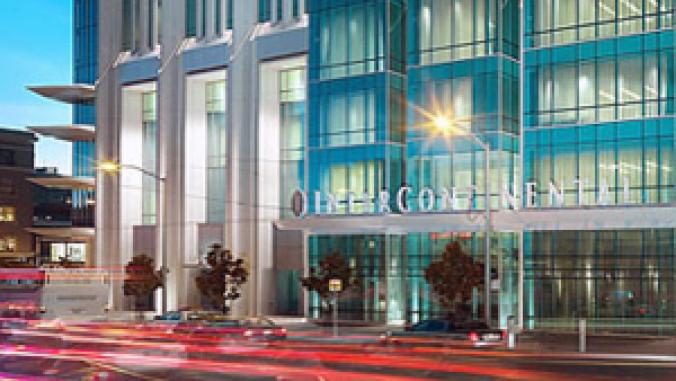U.S. Cement Industry Protests EPA's Proposal to Regulate Kiln Emissions
Advocates for the U.S. cement industry and environmentalists are facing off in hearings this week as federal regulators call for comment on new rules to limit emissions from the energy-intensive kilns that are core to the business.

Advocates for the cement industry in the U.S. and environmentalists are facing off in hearings this week as federal regulators call for comment on new rules to limit emissions from the energy-intensive kilns that are core to the business.
The regulations proposed by the Enivronmental Protection Agency would impose the nation's first limits on mercury emissions from existing Portland cement kilns, bolster the limits for new kilns and increase monitoring requirements.
The Portland Cement Association, the trade group for makers of the material, says the rules would be "devastating to the U.S. cement industry." Portland cement is the most commonly used type of cement in the world.
The association contends the regulations would result in $340 million in new costs to the industry, lead to a 10 percent drop in domestic production, make the business vulnerable to out-sourcing and jeopardize industry stability as the country seeks to pull out of its economic troubles.
Cement production is responsible for about 5 percent of the world's CO2 emissions. And the U.S. is the world's third-largest producer of cement behind China, the No. 1 producer, and India.
The EPA's new rules would affect 93 Portland cement manufacturing sites in the U.S. and Puerto Rico, the cement trade group says.
Environmentalists and people who live near the cement plants say the regulations, which were proposed in April, are a long time coming. Organizations such as the Natural Resources Defense Council have pushed federal regulators to curb kiln emissions for years.
Portland cement kilns are the fourth-largest source of mercury missions in the U.S., says the EPA. The kilns are heated to temperatures of 2,700-3,000 degrees Fahrenheit in order to convert raw materials that include lime, silica, aluminum and iron into Portland cement. Mercury and other hazardous emissions are released in burning fuels to heat the kilns and in the conversion process.
Airborne mercury, which deposits into water, can affect the kidneys and nervous system. Acute cases of exposure can lead to neuromuscular changes, slowed sensory and motor nerve function, reduction in cognitive function and renal failure.
The EPA's proposed regulations would result in slashing annual emissions of several substances related to Portland cement kiln operations. Releases of mercury would drop by 11,600 pounds, a reduction of 81 percent; total hydrocarbons, 11,700 tons, or 75 percent; particulate matter, 10,500 tons, or 96 percent; hydrochloric acid, 2,800 tons, or 94 percent; and sulfur dioxide,160,000 tons, or 90 percent, according to the EPA.
The agency is conducting hearings in three states this week to take public comment on the regulations, which if approved would take effect in 2013. The sessions began Tuesday in Los Angeles, continued today in Dallas and are scheduled to conclude tomorrow in the Washington, D.C., area.
In California, the nation's largest producer of cement, Portland Cement Association Vice President for Regulatory Affairs Andy O'Hare told regulators that the proposed rules would "undermine the stability of the domestic cement industry, endangering thousands of jobs and the supply of a basic construction material for uncertain environmental benefits," the Los Angeles Times reported.
This morning, North Texas resident Edgar Stahl, said he was not moved by the industry's claims. "Put them out of business until they can make clean cement," said Stahl, according to the Dallas Morning News.
Portland Cement Association represents about 40 companies that do business in the U.S. Eighty percent of U.S. cement plants are owned by overseas firms including Switzerland's Holcim, Lafarge of France, Germany's Heidelberg Cement, Italcementi, Cemex of Mexico and Taiheiyo Cement in Japan, Reuters reported.
There are different of types of cement, varying in terms of composition and application, for use in making concrete -- which is produced by mixing cement with aggregate and water. Portland cement, patented in the early 19th century, is so named because it produced a concrete whose color resembled limestone quarried on the Isle of Portland in England.
As the proposed U.S. regulations are being reviewed, an international effort is under way to make cement production cleaner and greener.
Earlier this month, the World Business Council for Sustainable Development released the results of its two-year project to identify the most effective ways to reduce greenhouse gas emissions in the global cement industry. It's strategy is to engage industry leaders to help develop and act on those methods.
Global greenhouse gas emissions for the industry could be reduced by as much as 25 percent by following the best practices developed by the WBCSD's Cement Sustainability Initiative, the group said.
Reducing CO2 emissions in the sector is key because the industry is expected to double by 2030. Currently, more than 80 percent of the world's cement is produced in developing countries. Although there are various types of cement, the basic elements of the production process are similar and involve a lot of heat, energy, dust and noise to quarry, grind, mix and convert the raw materials used in the operation.
The Cement Sustainability Initiative said that through its work, a CO2 accounting and reporting protocol has been tested, developed and is now used by more than 80 percent of the global cement industry. The CO2 reports of companies participating in the initiative are verified by an independent third party.
The initiative also developed a global database of energy and emissions data to enable the analysis and benchmarking of industry performance. The resource is managed by an independent third party on an open platform.
More information about the Cement Sustainability Initiative is available here.
Image by ilco.




